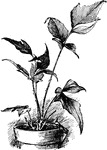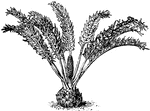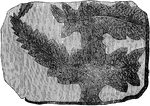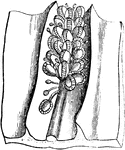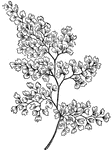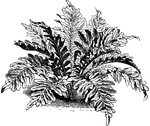The Ferns ClipArt gallery contains 178 illustrations of ferns from around the world. Ferns differ from normal plants (gymnosperms and angiosperms) by having spores instead of seeds, and are vasclar plants, differing from lycophytes by having true leaves, which are also known as megaphylls.
All illustrations in the ClipArt ETC collection are line drawings. If you are looking for color photographs of ferns, please visit the ClipPix ETC website.

Davallia Bullata
Davallia bullata has a creeping rootstock clothed with light, hair like scales. The leaves are scattered…
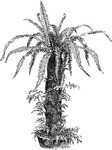
Dead Tree Fern, Decorated with Ferns
Tree ferns that are dead can be used but covering it with other small ferns for decoration.
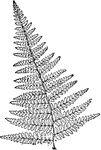
Dennstaedtia Punctiolbula
Illustrated is the tip of a leaf of dennstaedtia punctilobula. The leaves are one to two and a half…

Didymochlaena Lunulata
Didymochlaena lunulata is native from Cuba to Brazil. The leaves are clustered from an erect, rigid…
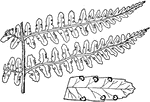
Dryopteris Marginalis
Dryopteris marginalis is native from Canada southward. It is a very common fern. The leaves are six…

Dryopteris Parasitica
Dryopteris parasitica is native to the tropical regions of both hemispheres. It often grows as a weed…
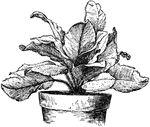
Elaphoglossum Crinitum
The common name of elaphoglossum crinitum is elephant ear fern. The blades are ten to eighteen inches…
Elaphoglossum Villosum
Elaphoglossum villosum is native to Mexico and the west Indies. The sterile blades are six to nine inches…

Fern Epidermis
"A, Upper epidermis; B, lower epidermis, of the fern, Drynaria meyeniana." -Gager, 1916

Fern Germination
"Germination of the spores of a fern. a, Before germination; b, early stage, showing protonema (pr.),…
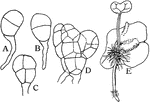
Fern Growth
"A, B, C, D, Successive stages of growth of prothallium from the spore in Osmunda cinnamomea; E, growth…
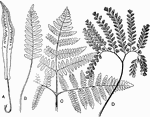
Fern Leaves
"Fern leaves, showing various degrees of subdivision or branching of the blade. A, Phyllitis; B, Polypodium;…
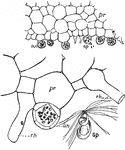
Fern Prothallus
"Fern prothallus; cross-sections showing antheridia (an), sperms (sp), and rhizoids (rh). Below at the…
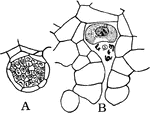
Fern Reproduction
"A, Antheridium containing sperm cells; B, archegonium containing an egg cell which has been found by…
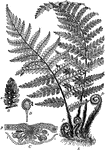
Fern Spore Plant
"Spore-plant of a fern (Aspidium filix-mas). A, part of a rootstock and fronds; fr, young fronds unrollin.…

Aerialroot Bristle Fern
The spore-cases and cup of Trichomanes radicans or the Aerialroot Bristle Fern.

Curlygrass Fern
Schizaea pusilla, or Little Curlygrass Fern is a small species of fern in the Curlygrass family (Schizaeaceae).…
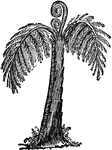
Giant Tree Fern
"The Fern is a leafy plant springing from a rhizome, which creeps below or on the surface of the ground…

Marratia Fern
"Top, lateral pinna from a leaf of Marattia jraxinea. Below at left, synangium of same. At right, corss-section…
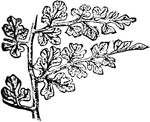
Seed Fern
A species of Seed Fern (Sphenopteris obtusiloba) is a fossil fern in the Carboniferous Era.
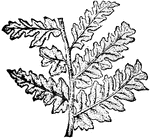
Seed Fern
A species of Seed Fern (Sphenopteris latifolia) is a fossil fern in the Carboniferous period.

Fossil Fern
Eremopteris artemisiaefolia is a species of "a genus of fossil ferns, separated from Sphenopteris."…

Fossil Tree Fern
"Portion of fossil tree fern (Pecopteris arborescens) on coal shale." -Taylor, 1904
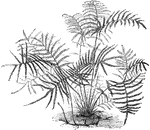
Gleichenia Circinata
The fronds of the gleichenia circinata fern have recurved margins. The branches can have fine short…
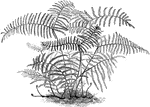
Gleichenia Circinata Semi-Vestita
Gleichenia circinata semi-vestita is very similar to gleichenia circinata. The young fronds of semi-vestita…

Frond of Gymnogramme Calomelanos Chrysophylla
Gymnogramme calomelanos chrysophylla ferns have dark racemes. The fronds have yellow powder.
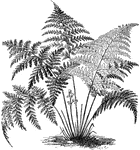
Gymnogramme Calomelanos Peruviana
Gymnogramme calomelanos peruviana ferns have smaller fronds than other gymnogramme ferns. The leaves…
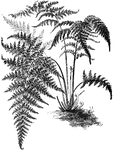
Gymnogramme Decomposita
Gymnogramme decomposita ferns have lance and triangular shaped fronds. This fern is covered in yellow…
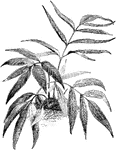
Gymnogramme Javanica
The fronds of the gymnogramme javanica fern are one to four feet long. The leaves are glossy.
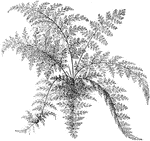
Gymnogramme Schizophylla
The fronds of the gymnogrammee schizophylla fern are one and a half to two feet long. The fronds gracefully…
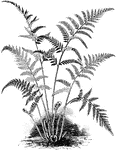
Gymnogramme Tartarea
Gymnogramme tartarea ferns have fronds that are one to two feet long. The powder on the fern is dense…

Hemionites Palmata
Hemionites palmata is a fern. The fronds are two to six inches long. The fronds are palm shaped with…

Hemitella Speciosa
The fronds of the hemitella speciosa fern are eight to twelve inches long and one to one and a half…

Wood Horsetail
"Equisetum sylvaticum: a, a, sheath crowned with teeth; b, branches; c, c, fruiting spikes. 2. Clypeola,…
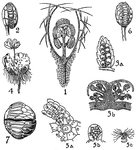
Hymenophyllaceae, Cyatheaceae, and Polypodiaceae
The hymenophyllaceae order consists of very delicate ferns. The cyatheaceae order usually consists of…
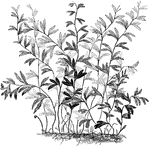
Hymenophyllum Falklandicum
The common name of hymenophyllum is Filmy Fern. The falklandicum variety is native to the Falkan Islands.…
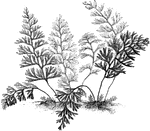
Hymenophyllum Turbridgense
The common name of hymenophyllum is filmy fern. The turbridgense variety has oblong fronds that taper…
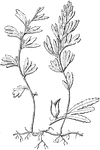
Habit and Detached Pinna with Involucre of Hymenophyllum Unilaterale
The common name of hymenophyllum is filmy fern. The unilaterale variety has dark green, rigid fronds.…
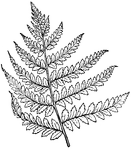
Lady Fern
The lady fern in the popular name of the fern 'Asplenium filix-foemina'. It is variable in size and…
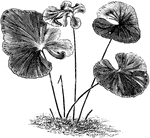
Lindsaya Reniformis
Lindsaya reniformis is a rare species of fern. The fronds are two to four inches across. The fronds…

Lomaria Alpina
The rhizome of the lomaria alpina stem is slender and wide creeping. There are both barren and fertile…
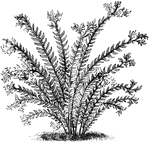
Lomaria Spicant Trinvervis Coronans
The tips of the lomaria spicant trinervis coronans fern have a large crest at the end.
Botrychium Lunaria Moonwort Fern with Root
"Moonwort, or moon—fern, in botany belonging to the order Ophioglossaceae. It has a tuberous root—stock…

Lygodium Japonicum
Lygodium japonicum is a climbing fern. The fern is native to Japan and the east Indies.
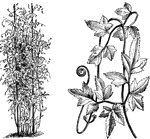
Habit and Portion of Detached Frond of Lygodium Japonicum
The primary leafstalk of lygodium japonicum is very short. The secondary leafstalk is a half inch to…
Lygodium Palmatum
The primary leafstalk of lygodium palmatum is very slender, about an eighth of an inch to a quarter…


